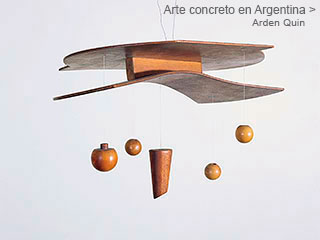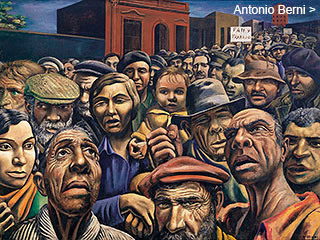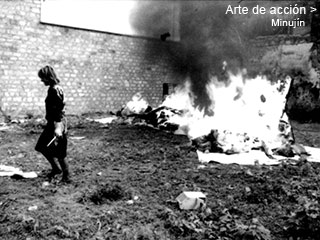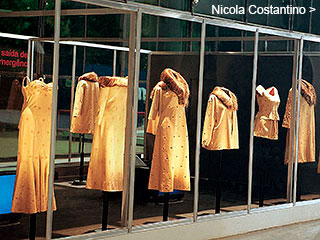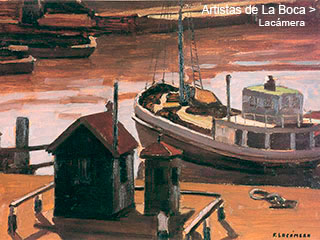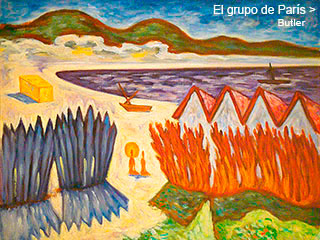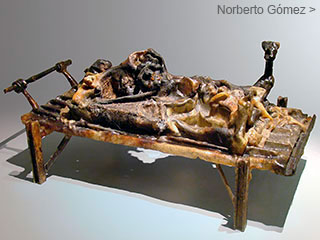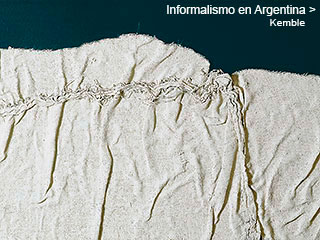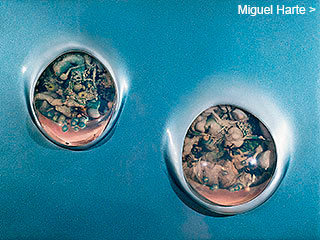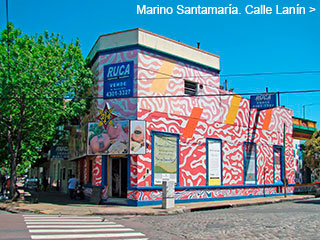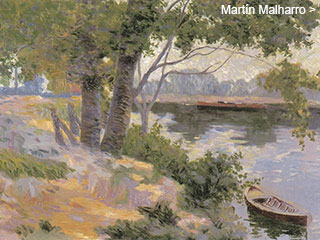Menú
Algunos dossiers
Concrete Art
in Argentina
in Argentina
by
Adriana Lauria
January 2003
January 2003
Abstraction asserted itself in Argentina through the achievements of groups such as Arte Concreto-Invención, Madí and Perceptismo, which developed their activity since the second half of the 1940s. These groups constituted the first organized national avant-garde and made their aesthetics known to the public through exhibitions, magazines, manifestoes, leaflets, lectures, etc.
Documents
Tomás Maldonado
Tomás Maldonado.“The Concrete Artists, ‘Realism’ and Reality”, in Arte Concreto-Invención magazine. Buenos Aires, August 1946, No. 1,
p. 10.
p. 10.
While a century ago painter Horacio Vernet would boast of being Horacio Vernet, that can no longer be said about his descendents and loyal followers in our days, who refuse to be judged for what they are. Bouguereau’s reactionary arrogance, which astounded Cézanne, has been replaced today with a shaming reactionaryism –less insolent but more harmful–, which attempts, by all means, to exhibit itself connected with all the best and most popular ideas in our time. Indeed, the bourgeois artistic reaction today claims to be realistic, humanistic and revolutionary. Taking advantage of the millenary interpretation mistake –stressed from Renaissance to present days, most specially since Courbet– according to which the more imitative a painting, the more realistic it is judged to be, while they consider that the representative verism is nearer from Humanism than any other tendency, the reactionaries show, as a novelty, the still unburied formal modalities of the bourgeois academies; formal modalities they label “realistic” and that, ultimately, do not represent but the artistic copy of their bourgeois, idealistic notion of reality. “This dog is not a real but a painted one”, Petronio calls in front of a Roman fresco representing such animal.
Representative art is not realistic; it could never be that: it only creates phantoms of things. To us, Marxists, real is what can be verified through action, practice.
“The success of our acts –Engels wrote– proves the correspondence between our perception and the objective nature, the perceived things”. A graphic representation, mechanic (photography) or manually performed (which may be a means of knowledge), is an illusion, a knowledge simulacrum. A graphic representation is the abstract immobilization of a single moment in the cognitive process, never knowledge itself. To claim the latter is to fall back to Berkeley.
Imagination can be systematically swindled while man will not succumb; but that will not happen with knowledge. Not even a presumed representative beauty could justify the treason to knowledge.
The essential thing is practice, for only practice empowers for action, to KNOW effectively an object implies an unrestrained joy for man, an assertion of his power.
It cannot be humanist, therefore, an activity that weakens man, which causes him to mistrust his own power for knowledge and action.
Reaction also has its theorists; we are aware of their language: mediumnical aptitudes, revealing intuition, phenomenon and thing-in-itself... “Ghost stories”, Lenin used to call considerations of this kind; “ghost stories” as the very art they attempt to defend.
Concrete art will be the future’s socialist art.
Concrete art is an art of INVENTION.
Concrete art is practice. Consciousness arises from the world but it also operates upon it, IT INVENTS. To invent, not according to Bergson, but to Marx, that is to say, PRACTICE, WORK.
Our art does not flow into humiliation, or skepticism, or melancholy.
We know who are against us, and we are glad about it.
Against us there are the muralist Neo-realists (the bourgeoisie longs to have their Laocoön); there are the lotheists, modernity’s demagogues; there are the painters of “very thin grays”; there are the lyrics who notice the “lofty sentimental value of a grazing horse” or the “deep contents of certain glances”; there are, finally, the anguished little tubbies in the Department of Culture, climbers of the Christian guilt, who hate our art for its being joyful, clear and constructive.
With us, instead, stays the best and less contaminate of the new groups of artists...
Concrete art is the only realistic, humanistic and revolutionary art.


